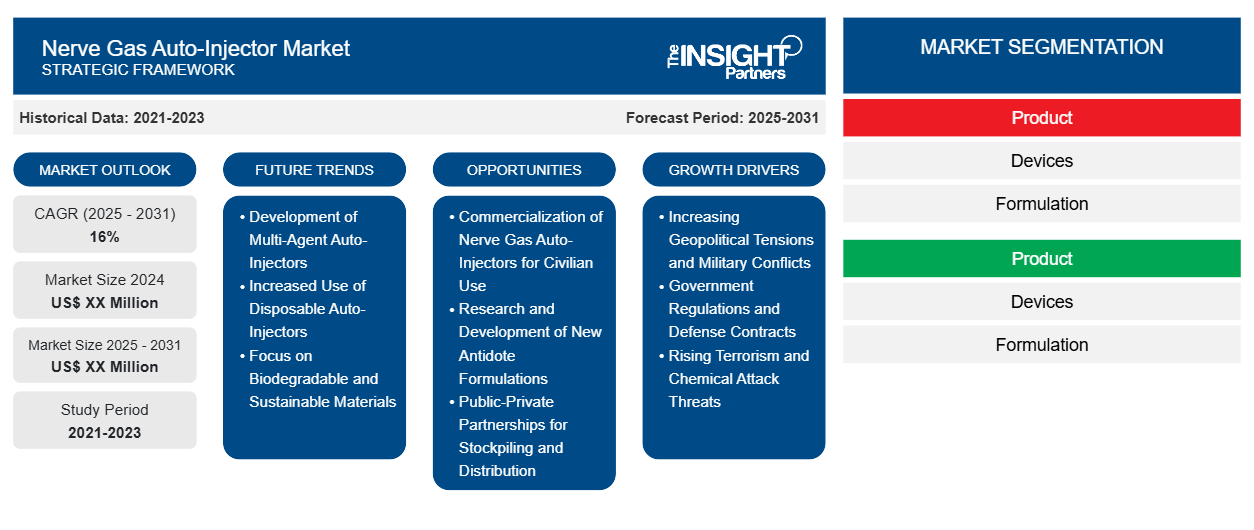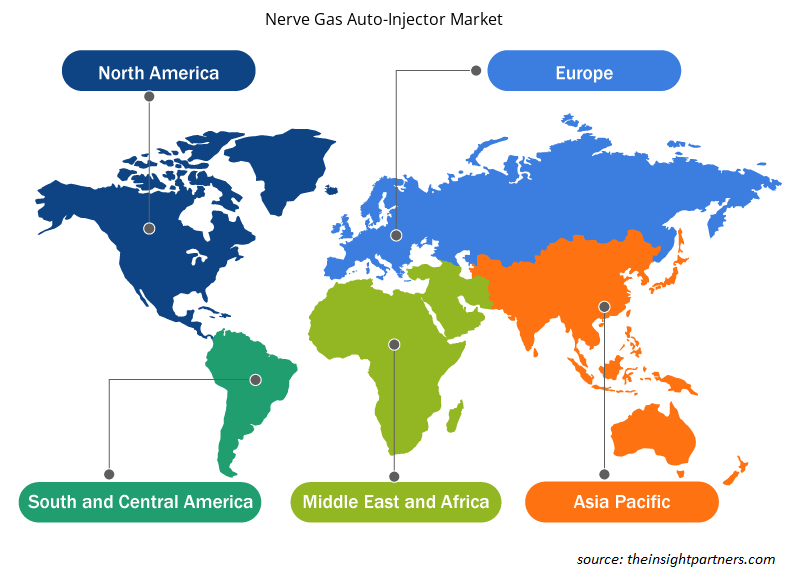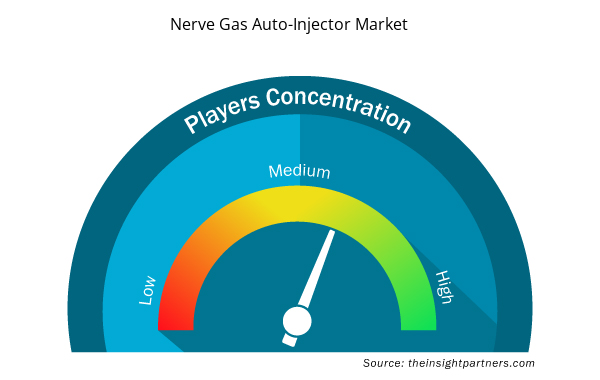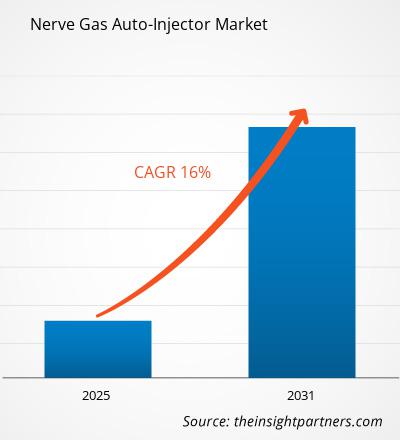The Nerve Gas Auto-Injector Market is expected to register a CAGR of 16% from 2025 to 2031, with a market size expanding from US$ XX Million in 2024 to US$ XX Million by 2031.
The research report on the Nerve Gas Auto-Injector Market is segmented by product into devices and formulations. Applications analyzed include Atropine, Pralidoximechloride, Diazepam, and Morphine. End-users include government defense agencies, pharmaceutical companies, hospitals, and first responders. The regional analysis covers key markets such as North America, Europe, Asia Pacific, the Middle East and Africa, and South America. The market evaluation is presented in US$ for all segmental analyses. This report focuses on the growing importance of nerve gas auto-injectors in emergency response scenarios, as well as advancements in auto-injector design and efficacy.
Purpose of the Report
The report Nerve Gas Auto-Injector Market by The Insight Partners aims to describe the present landscape and future growth, top driving factors, challenges, and opportunities. This will provide insights to various business stakeholders, such as:
- Technology Providers/Manufacturers: To understand the evolving market dynamics and know the potential growth opportunities, enabling them to make informed strategic decisions.
- Investors: To conduct a comprehensive trend analysis regarding the market growth rate, market financial projections, and opportunities that exist across the value chain.
- Regulatory bodies: To regulate policies and police activities in the market with the aim of minimizing abuse, preserving investor trust and confidence, and upholding the integrity and stability of the market.
Nerve Gas Auto-Injector Market Segmentation
Product
- Devices
- Formulation
Product
- Devices
- Formulation
You will get customization on any report - free of charge - including parts of this report, or country-level analysis, Excel Data pack, as well as avail great offers and discounts for start-ups & universities
Nerve Gas Auto-Injector Market: Strategic Insights

- Get Top Key Market Trends of this report.This FREE sample will include data analysis, ranging from market trends to estimates and forecasts.
Nerve Gas Auto-Injector Market Growth Drivers
- Increasing Geopolitical Tensions and Military Conflicts:
Nerve agents, such as sarin and VX, are among the most dangerous chemical weapons, and their potential use in military conflicts, terrorist attacks, or other forms of warfare is a significant driver of the demand for nerve gas auto-injectors. As geopolitical tensions rise globally, there is a growing focus on defense preparedness, including ensuring military personnel and first responders are equipped with protective and counteractive measures against chemical warfare agents. The development and deployment of auto-injectors capable of rapidly administering antidotes like atropine or pralidoxime chloride is crucial in these scenarios to neutralize the effects of nerve agents. With ongoing conflicts and concerns over chemical warfare, the demand for these life-saving devices is expected to grow.
- Government Regulations and Defense Contracts:
Government agencies, especially defense departments across the world, are key drivers of the nerve gas auto-injector market. The U.S. Department of Defense (DoD) and other military organizations maintain large stockpiles of nerve gas antidotes for military personnel, and contracts for the production and supply of nerve gas auto-injectors represent a significant portion of the market. In many countries, governments have enacted regulations to ensure that emergency responders, military personnel, and even civilians in certain high-risk areas have access to these devices in case of a nerve agent attack. The consistent supply and replacement of these injectors, as well as research into more advanced formulations and delivery methods, further fuel market growth.
- Rising Terrorism and Chemical Attack Threats:
The threat of chemical terrorism, particularly nerve agents being used in civilian environments, is a growing concern. High-profile attacks involving chemical weapons, such as the 2013 sarin gas attack in Syria and the 1995 Tokyo subway attack, have heightened awareness about the need for preparedness. In response, there is an increasing focus on developing systems and training for civilian populations, first responders, and healthcare workers to mitigate the effects of nerve agent exposure. The availability of nerve gas auto-injectors for emergency use is seen as essential for protecting populations from the potentially catastrophic consequences of such attacks.
Nerve Gas Auto-Injector Market Future Trends
- Development of Multi-Agent Auto-Injectors:
One of the trends in the market alley is the development of multi-agent auto-injectors. Traditional nerve gas auto-injectors usually consisted of a single antidote, like atropine. However, new models are developed with multiple drugs in a single device. This trend tends to become especially important in more complex nerve agent exposure cases where a combination of antidotes might be required to neutralize different types of nerve agents effectively. For instance, in-depth cases might require somatic antagons, like atropine, pralidoxime chloride, and diazepam, to address both the toxic effects of nerve agents and the resulting seizures. Multi-agent auto-injectors will take out some complexity from the treatment process that can shorten the time required for antidote administration and hence improve outcomes for victims of nerve agent exposure. - Increased Use of Disposable Auto-Injectors:
The rise of more convenient, safer (with regard to contamination and misapplication) disposable auto-injectors is now a trend. Due to their relatively lower cost and more straightforward usage in emergencies, disposable devices are critical for civilian use, military, and emergency response personnel. In addition, the pre-filled single-use auto-injectors allow rapid effective treatment, especially in situations where prompt therapies are required. Furthermore, in line with trends toward disposable devices, such devices would ease equipment maintenance requirements and eliminate specialized training to handle complex reusable devices. - Focus on Biodegradable and Sustainable Materials: Sustainability in the medical device industry, including the nerve agent auto-injector market, is gaining traction. Manufacturers are increasingly seeking ways to design auto-injectors using biodegradable or more environmentally friendly materials. These developments will reduce the environmental hazard of discarded devices while ensuring that injectors are still effective in emergency situations.
Nerve Gas Auto-Injector Market Opportunities
- Commercialization of Nerve Gas Auto-Injectors for Civilian Use: As threats from chemical warfare extend beyond military environments, there is an opportunity to expand the market for nerve gas auto-injectors into civilian sectors. Some regions, particularly high-risk urban areas, may require these devices for first responders and emergency medical personnel. In addition, there could be potential to market these products to certain industries or sectors where employees are at higher risk of exposure, such as those working in chemical manufacturing or research. Expanding the market to include civilian applications could significantly boost overall market growth.
- Research and Development of New Antidote Formulations: The development of more effective and faster-acting antidotes for nerve agent exposure presents a significant opportunity in the nerve gas auto-injector market. While atropine and pralidoxime chloride are the most commonly used antidotes, ongoing research into more advanced antidote formulations that are more effective in neutralizing a broader range of nerve agents could lead to new product offerings in the market. By improving the effectiveness of these drugs, auto-injectors could offer faster, more efficient treatment for nerve agent exposure, improving overall patient outcomes and broadening the scope of their application.
- Public-Private Partnerships for Stockpiling and Distribution: Public-private partnerships can provide a valuable opportunity for the market to grow. Governments may collaborate with private companies to ensure the production, stockpiling, and distribution of nerve gas auto-injectors on a national scale. This can involve setting up supply chains that ensure rapid deployment in the event of an attack or exposure incident. By ensuring that auto-injectors are readily available in high-risk areas and that appropriate training is provided to healthcare workers, emergency responders, and military personnel, such partnerships can enhance the overall efficacy of the response to chemical warfare incidents.
Nerve Gas Auto-Injector Market Regional Insights
The regional trends and factors influencing the Nerve Gas Auto-Injector Market throughout the forecast period have been thoroughly explained by the analysts at Insight Partners. This section also discusses Nerve Gas Auto-Injector Market segments and geography across North America, Europe, Asia Pacific, Middle East and Africa, and South and Central America.

- Get the Regional Specific Data for Nerve Gas Auto-Injector Market
Nerve Gas Auto-Injector Market Report Scope
| Report Attribute | Details |
|---|---|
| Market size in 2024 | US$ XX Million |
| Market Size by 2031 | US$ XX Million |
| Global CAGR (2025 - 2031) | 16% |
| Historical Data | 2021-2023 |
| Forecast period | 2025-2031 |
| Segments Covered |
By Product
|
| Regions and Countries Covered | North America
|
| Market leaders and key company profiles |
Nerve Gas Auto-Injector Market Players Density: Understanding Its Impact on Business Dynamics
The Nerve Gas Auto-Injector Market is growing rapidly, driven by increasing end-user demand due to factors such as evolving consumer preferences, technological advancements, and greater awareness of the product's benefits. As demand rises, businesses are expanding their offerings, innovating to meet consumer needs, and capitalizing on emerging trends, which further fuels market growth.
Market players density refers to the distribution of firms or companies operating within a particular market or industry. It indicates how many competitors (market players) are present in a given market space relative to its size or total market value.
Major Companies operating in the Nerve Gas Auto-Injector Market are:
- MERIDIANMEDICALTECHNOLOGIES
- OWENMUMFORD
- YPSOMEDHOLDINGAG
- SOPHARMA
- HIKMAPHARMACEUTICALSPLC
- HOSPIRA
Disclaimer: The companies listed above are not ranked in any particular order.

- Get the Nerve Gas Auto-Injector Market top key players overview
Key Selling Points
- Comprehensive Coverage: The report comprehensively covers the analysis of products, services, types, and end users of the Nerve Gas Auto-Injector Market, providing a holistic landscape.
- Expert Analysis: The report is compiled based on the in-depth understanding of industry experts and analysts.
- Up-to-date Information: The report assures business relevance due to its coverage of recent information and data trends.
- Customization Options: This report can be customized to cater to specific client requirements and suit the business strategies aptly.
The research report on the Nerve Gas Auto-Injector Market can, therefore, help spearhead the trail of decoding and understanding the industry scenario and growth prospects. Although there can be a few valid concerns, the overall benefits of this report tend to outweigh the disadvantages.
- Historical Analysis (2 Years), Base Year, Forecast (7 Years) with CAGR
- PEST and SWOT Analysis
- Market Size Value / Volume - Global, Regional, Country
- Industry and Competitive Landscape
- Excel Dataset


- Visualization and 3D Rendering Software Market
- Adaptive Traffic Control System Market
- Joint Pain Injection Market
- High Speed Cable Market
- Compounding Pharmacies Market
- Airline Ancillary Services Market
- Nuclear Waste Management System Market
- Online Exam Proctoring Market
- Long Read Sequencing Market
- Medical Second Opinion Market

Report Coverage
Revenue forecast, Company Analysis, Industry landscape, Growth factors, and Trends

Segment Covered
This text is related
to segments covered.

Regional Scope
North America, Europe, Asia Pacific, Middle East & Africa, South & Central America

Country Scope
This text is related
to country scope.
Frequently Asked Questions
What is the expected CAGR of the Nerve Gas Auto-Injector Market?
The Nerve Gas Auto-Injector Market is expected to register a CAGR of 16% from 2025-2031.
What are the driving factors impacting the Nerve Gas Auto-Injector Market?
The major driving factors supporting the Nerve Gas Auto-Injector Market growth are- Increasing Geopolitical Tensions and Military Conflicts, Government Regulations and Defense Contracts, and Rising Terrorism and Chemical Attack Threats
What are the future trends in the Nerve Gas Auto-Injector Market?
Key Future Trends in the Nerve Gas Auto-Injector Market are-Development of Multi-Agent Auto-Injectors, Increased Use of Disposable Auto-Injectors, and Focus on Biodegradable and Sustainable Materials
Which are the key players in the Nerve Gas Auto-Injector Market?
Key companies in Nerve Gas Auto-Injector Market are - MERIDIANMEDICALTECHNOLOGIES , OWENMUMFORD , YPSOMEDHOLDINGAG , SOPHARMA , HIKMAPHARMACEUTICALSPLC , HOSPIRA , SANOFISA , AKTIVPHARMAGROUP
What are the deliverable formats of the Nerve Gas Auto-Injector Market?
The report can be delivered in PDF/PPT format; we can also share excel dataset based on the request.
What are the options available for the customization of this report?
Some of the customization options available based on request are additional 3–5 company profiles and country-specific analysis of 3–5 countries of your choice. Customizations are to be requested/discussed before making final order confirmation, as our team would review the same and check the feasibility.
Trends and growth analysis reports related to Life Sciences : READ MORE..
1. MERIDIAN MEDICAL TECHNOLOGIES
2. OWEN MUMFORD
3. YPSOMED HOLDING AG
4. SOPHARMA
5. HIKMA PHARMACEUTICALS PLC
6. HOSPIRA
7. SANOFI S.A.
8. AKTIV PHARMA GROUP

 Get Free Sample For
Get Free Sample For